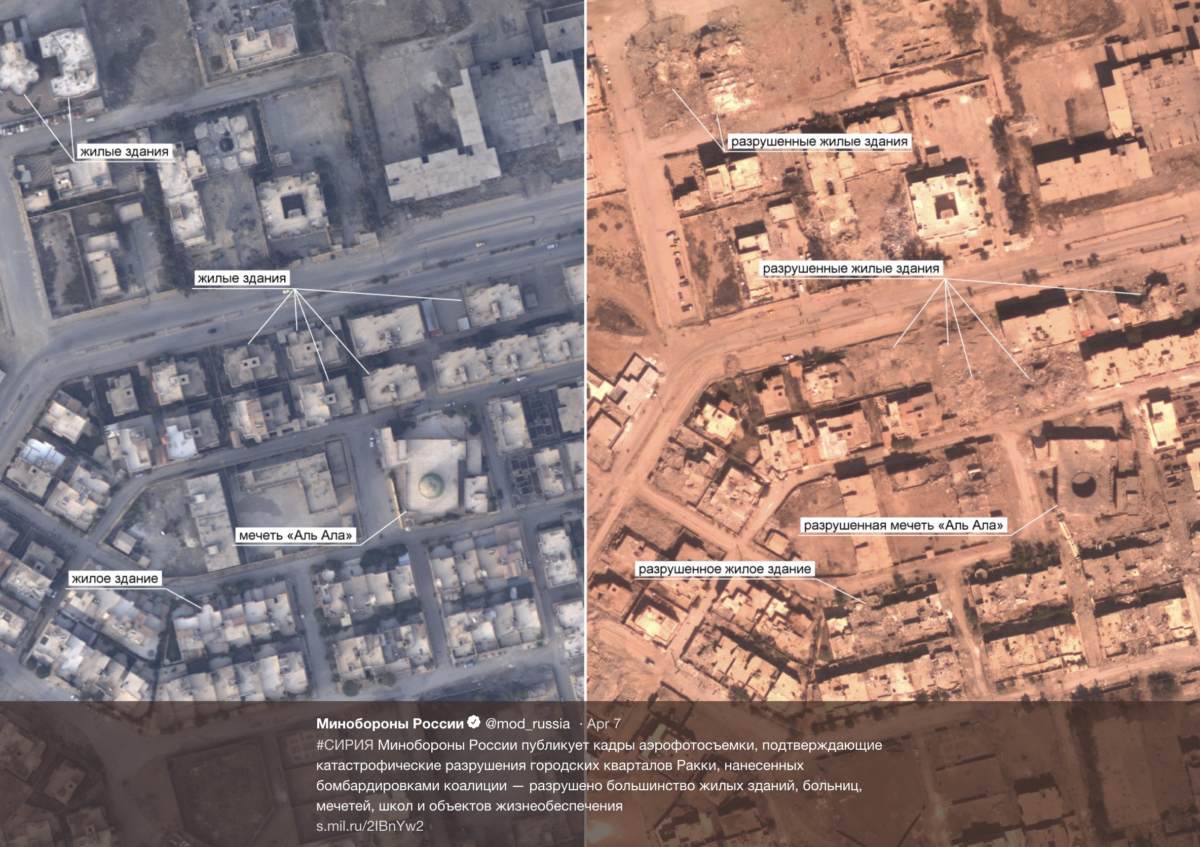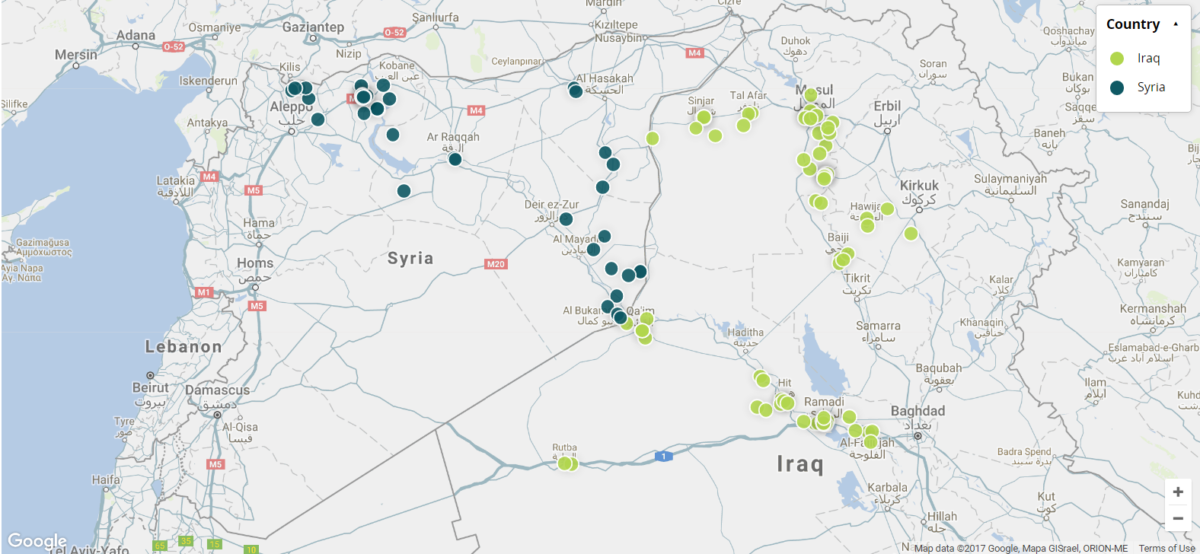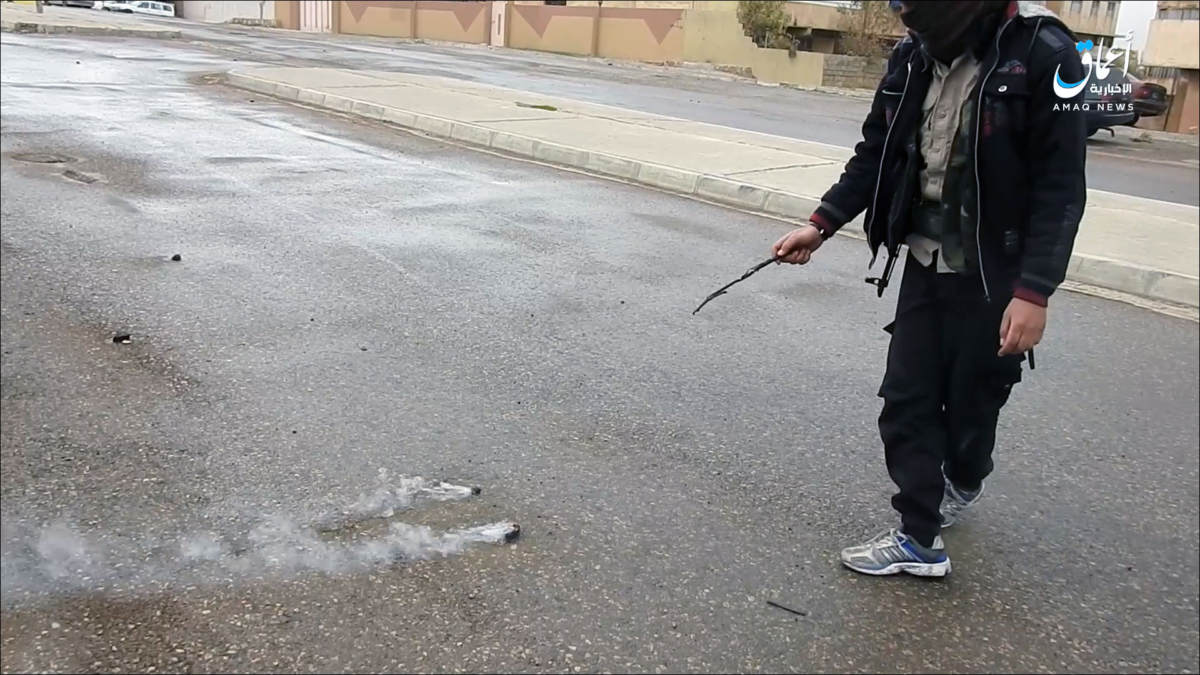Who Killed Adnani? An Open Source Survey
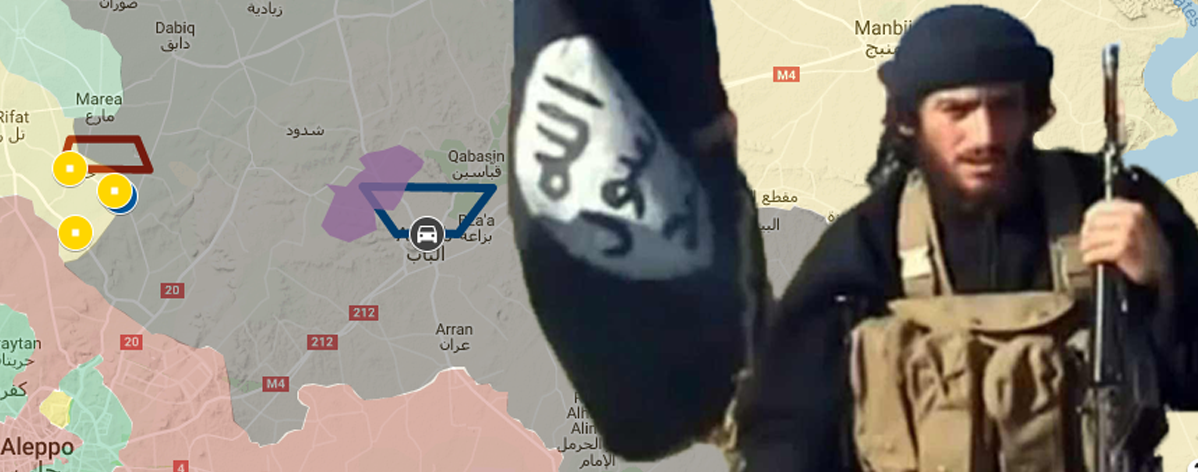
Fig. 1 — Abu Muhammad al-Adnani, chief spokesperson for the so-called Islamic State, allegedly in Syria in a video published by so-called Islamic State. A screenshot of the video was cut out and placed in front of the Google overview map for this article.
On August 30, 2016, ʻAmāq News Agency announced the death of the 39-year old Ṭaha Subhī Falaḥa (1977), better known as Abū Muhammad al-‘Adnānī (Arabic: أبو محمد العدناني; hereafter simply referred to as ‘Adnani’), the chief spokesperson for the so-called Islamic State (IS).
The killing of Adnani is a significant blow for IS, given his prominent within the organisation as has been discussed in detail by Kyle Orton (The Syrian Intifada), Thomas Joscelyn (The Long War Journal), and Michael Weiss (The Daily Beast). Adnani was listed as a specially designated global terrorist pursuant by the United States (US) Department of State in August 2014 with a bounty of up to five million US dollars on ‘information that brings justice’.
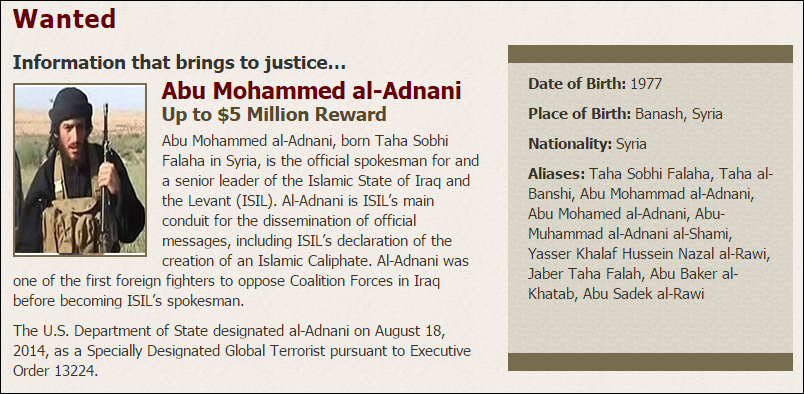
Fig. 2 — The US Department of Defense has a reward of up to five million US dollars on ‘information’ leading to Adnani. This is a screenshot from the US DoD’s website as of September 1, 2016.
Both the Russian Federation as well as the US, who are leading the Combined Joint Task Force – Operation Inherent Resolve (‘the Coalition’), have claimed to have carried out the airstrike that led to the killing of Adnani, although with conflicting claims on the location where he was killed within Syria’s Aleppo province.
So far, neither IS has published footage that could confirm the death of Adnani nor the Coalition or Russia have published footage of their alleged airstrike on Adnani. US Defence officials said Russia’s claim was ‘a joke’ and ‘garbage‘. The Russian Ministry of Defence (MoD) responded to the allegation in a Facebook post, claiming the Russian Air Force ‘effectively eliminate all terrorist [sic] without unreasonable hunt for separate individuals’ and that the US strikes ‘kill common [citizens] instead of terrorist leaders.’
This article takes a closer look at the incident examining the open sources that are available at the moment. What can they tell us about the alleged killing of Adnani?
Overview map
The overview map shows the different, sometimes corroborated, open source information relater to the alleged death of Adnani. Each item is clickable and will show a description what it displays. For example, the red rectangular is the area where Russian strikes were reported on the ground, while the blue rectangular shows the area where the US said it conducted airstrikes. These areas are approximately 25 kilometres apart. The area marked in purple is the area where an unidentified aircraft was circling for over six hours before Adnani was announced killed. The territorial control shown is based on Liveuamap and shows the YPF/SDF (yellow), IS (black), the Syrian government and allies (red), and a wide variety of Syrian armed opposition factions (green).
Islamic State: ‘martyred while surveying operations’
IS-linked ʻAmāq announced the death of Adnani on August 30, stating he ‘was martyred while surveying the operations to repel the military campaigns against Aleppo.’ The publication timestamp of the news report in ʻAmāq’s Telegram channel could not be retrieved, but the report first emerged on Twitter [archived] at 17:48 UTC. The English news report was published on their Telegram account at 17:51 UTC. Neither an exact location nor information on who carried out the attack was given.
Amaq announces the death of #IS spokesman Abu Muhammad al-Adnani pic.twitter.com/S2VxlnL1Rx
— Pieter Nanninga (@pieternanninga) August 30, 2016
A more detailed, official confirmation from IS’ Aleppo media outlet started circulating on Twitter a few hours later. Again, no exact location was given but the announcement referred to ‘Halab Wilayah’, the Aleppo province as defined by IS. The same text was published in an-Nabā, the newspaper of IS, which was distributed hours after the ʻAmāq announcement.
A longer English translation of how Adnani was killed, published by ISIS media. #Syria #ISIS #Adnani pic.twitter.com/IiKnawxqYp
— Amarnath Amarasingam (@AmarAmarasingam) August 30, 2016
The claims of IS thus only give an indication of time period, August 30 or earlier, and a rough location, the Aleppo province.
Russian Ministry of Defence: killed near ‘Um Ḥūsh
The Russian MoD claimed on its Facebook-page that a Su-34 fighter jet had struck ‘a large concentration of [IS] militants’ near ‘Maaratat-Um-Haush’ in the Aleppo province. Based on ‘several intelligence channels’, the Russian MoD believes Adnani was among those IS fighters. The Russian announcement was published on Facebook at 11:30 UTC on August 31. An English translation of the same statement followed 23 minutes later at at 11:53 UTC [archived here].
#SYRIAOn August 30, 2016, the strike of a Russian bomber #Su34 carried out near the Maaratat-Um-Haush (#Aleppo…
Geplaatst door Минобороны России op Woensdag 31 augustus 2016
‘Maaratat-Um-Haush’ seems to refer to the village of Ma’arātat ‘Um Ḥūsh (Arabic: معراتة أم حو; also referred to as ‘Umm Hawsh’, ‘Hosh’, ‘Housh’) which is located (Wikimapia) on the frontline between IS and the Kurdish People’s Protection Units (Kurdish: Yekîneyên Parastina Gel; YPG), which are part of the Syrian Democratic Forces (SDF) alliance. On August 30, clashes were reported between YPG/SDF and IS in this area, with the YPG/SDF eventually capturing three villages, including ‘Um Ḥūsh.
Breaking: #Hara_FM reporter: YPG in #Efrin are advancing East after clashes with #ISIS in Umm Housh and Umm al-Qura pic.twitter.com/kaLEOdADMy
— Radio Hara – English (@RadioHaraEngl) August 30, 2016
MAP: YPG from Afrin takes 3 towns from #ISIS in N. #Aleppo. Now 30km from al-Bab – @markito0171 pic.twitter.com/uYUXBAUc4C
— Conflict News (@Conflicts) August 30, 2016
However, YPG/SDF were not able to control the village for too long as they were ambushed later that day and subsequently lost control of ‘Um Ḥūsh. Following the recapture by IS, airstrikes allegedly pounded the village.
These airstrikes were Russian, according to Twitter-user ‘yasser alhaji’ who uploaded a video allegedly showing airstrikes 5 kilometers south of Mare’ (Arabic: مارع). The video has not been geolocated, but the uploader of the video confirmed to Bellingcat that it was indeed filmed very close to ‘Um Ḥūsh, as the map below shows (full map here).
From the battle between isis and SDF with Russian air support.. pic.twitter.com/Dc4oLCPvi6
— yasser alhaji (@yasseralhaji1) August 30, 2016

Fig. 3 — An overview of the location where of the alleged Russian airstrikes. Full map can be found here.
But ʻAmāq reported Coalition airstrikes on ‘Um Ḥūsh as well, ‘as battles rage between [IS] forces and YPG fighters inside the village’. The English report was uploaded to their Telegram channel at 11:15 UTC on August 30.

Fig. 4 — ʻAmāq claimed on their Telegram channel that the US struck the village of ‘Um Ḥūsh on August 30, 2016.
The Coalition’s own daily reports mention six strikes near Manbij on August 30 on ‘four separate [IS] tactical units, and destroying five fighting positions, a vehicle, a weapons cache, and two vehicle-borne improvised devices [VBIEDs]’.
Geolocation of official Coalition airstrike videos, a crowdsourced project by Bellingcat, shows that the use of ‘near’ could well be 50 kilometres further than the location mentioned. An example is a ‘near Manbij’ airstrike video that was geolocated by Twitter-user @obretix near a village around 50 kilometres southeast of Manbij.
@obretix has geolocated the lion’s share of the Coalition (and Russian) official airstrike videos, and has mapped the locations mentioned by the Coalition using Voronoi diagrams. A Voronoi diagram is a partitioning of a into areas based on the distance to certain points, in this case the ‘near’ locations in Syria and Iraq.
Interestingly, when taking this map into account, one would assume that the Coalition would label an airstrike near ‘Um Ḥūsh as ‘near Mare’’ or ‘near Washiyah’ rather than ‘near Manbij’, as these labels used before are closer to the struck location. On August 31, the Coalition indeed mentions that ‘Near Washiyah, one strike engaged an ISIL tactical unit, and destroyed a vehicle.’
The vehicle ‘near Manbij’ mentioned in the August 30 report could thus well be the airstrike in al-Bab. If it would have been in ‘Um Ḥūsh, it most likely would be labelled as ‘near Washiyah’, which was a strike mentioned in the August 31 report.
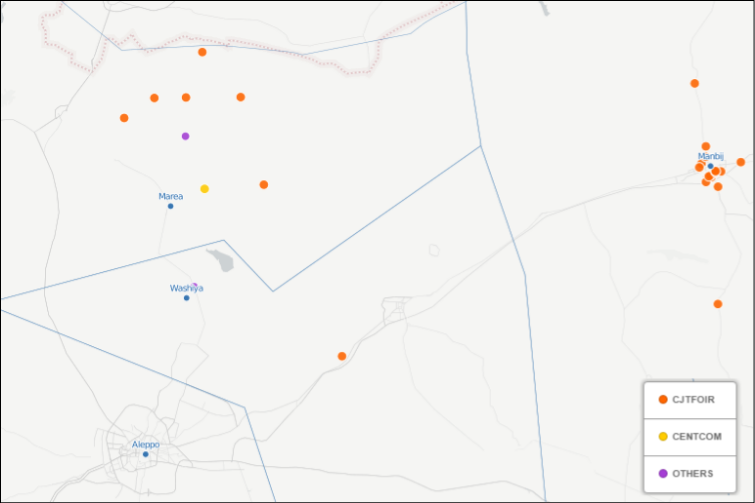
Fig. 5 — An excerpt of obretix’s map of Coalition locations. Full map can be found here.
But the US claims that Adnani was not killed near Mare’, but north of the IS-controlled city of al-Bab.
The Pentagon: Adnani killed in ‘a precision strike near Al Bab’
On August 30, the US Department of Defense (DoD) published a statement [archived] claiming they had killed Adnani in ‘a precision strike near Al Bab’ while ‘still assessing the results of the strike’. Finding an exact timestamp is difficult, but the statement was first tweeted at 0:22 UTC on August 31, and Peter Cook, spokesperson for the Pentagon, tweeted the statement at 00:36 UTC.
Later, a US official told Washington Post journalists Andrew Roth, Liz Sly, and Thomas Gibbons-Neff that the US strike on Adnani was conducted by an unmanned aerial vehicle (UAV) firing Hellfire missiles ‘on the northern edge of the town of Bab, about three miles [~4.8km] from the town center’. The Pentagon believes that the IS spokesperson ‘was traveling in a vehicle at the time with at least one other person’.
There is a small but significant difference in the US and Russian claims. While they both claim to be responsible for Adnani’s death, only the US states it targeted Adnani. Russia says it received intelligence after it bombed IS militants that Adnani was among them.
An unknown aircraft with no call sign was shown on Flightradar24 orbiting northeast of Al Bab for over six hours on August 29, as several people noted (e.g. Avi Scharf at 15:53 UTC on Twitter, ‘Dr Nooooo’ on Reddit at 20:06 UTC). Flightradar24 is a flight tracker website which show live air traffic from around the world, based on several data sources. This specific flight was shown by T-MLAT1.
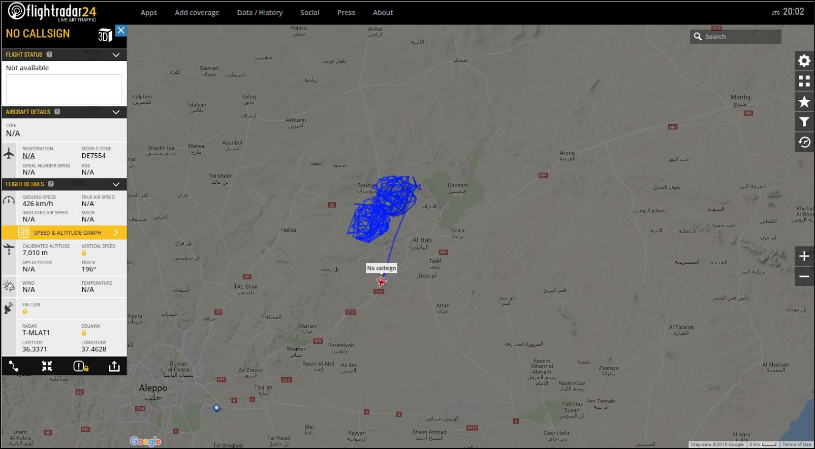
Fig. 6 — A screenshot of Flightradar 24, which showed an unknown aircraft with no call sign orbiting northeast of Al Bab for over six hours on August 29.
What is interesting to note is that a week earlier, on August 23, IS fighters claimed to have shot down a cannister-launched surveillance drone used by Syrian rebels in northern Aleppo province. Various analysts on Twitter who closely watch drone deployment in Syria wondered what the high-value target (HVT) could have been to launch a type of drone previously unseen during the conflict.
IS claims its fighters downed a surveillance drone used by Syrian opp. brigades in Northern countryside of #Aleppo pic.twitter.com/CopGYR9noF
— Caspar Schliephack (@SerioSito) August 23, 2016
Though remarkable, there does not need to be a correlation between the unidentified aircraft and alleged killing of Adnani, or the above drone. It may well be coincidence, which thus shows a limitation of open source investigation.
When looking at airstrike claims near al-Bab on August 30, the ‘al-Bab city coordination’ indeed reported airstrikes at 14:37 but said there were no casualties [archived].
#الباب : قصف على المدينة بأربع صواريخ من الراجمات استهدف شارع قديران ولا أنباء عن إصابات، بالتزامن مع تحليق الطيران الاستطلاعي والحربي
— تنسيقية مدينة الباب (@albab_city) August 30, 2016
Later, at 17:55 UTC, Twitter-user @ahmad09904 wrote that the car targeted at noon at the Qedairan junction in the northern part of al-Bab was conducted by the Coalition and killed Adnani around noon [archived].
السيارة التي تم استهدافها من قبل التحالف الدولي اليوم ظهراً بالقرب من مفرق قديران على أطراف مدينة #الباب كان يتواجد فيها ابو محمد العدناني
— ahmad mohamad (@ahmad09904) August 30, 2016
Mousa al-Omar followed at 19:13 UTC with the same claim, citing ‘an [IS] source’. He added that Adnani was killed with his five guards and was observed by aircraft for several hours after arriving from ar-Raqqah [archived].
وفقاً للمصدر : هذا المكان الذي تم استهداف العدناني فيه بالباب مفرق قديران بعد رصده بطائرتي استطلاع راقبته طوال الليل pic.twitter.com/jwBxm6X3i3
— موسى العمر (@MousaAlomar) August 30, 2016
The Washington Post article also mentioned a Syrian news website, Syrian View, that Adnani was killed ‘just outside Bab around 3 p.m.’ by a Coalition airstrike, while on his way to the frontline near Manbij. As mentioned before, the Coaliton did mention airstrikes on a vehicle ‘near Manbij’ on August 30.
But was Adnani really killed by an airstrike? Is he really dead?
On August 31, a theory started circulating on Telegram and Twitter that it was neither a Russian nor a Coalition airstrike that killed Adnani, but IS itself; an inside job. Adnani was killed by an improvised explosive device (IED) placed in the car he was travelling in by those loyal to Abū Luqmān (Arabic: أبو لقمان; hereafter simply referred to as Abu Luqman), according to the theory.
Abu Luqman, whose real name is as Ali Moussa al-Hawikh, was the first governor of IS-controlled ar-Raqqah and was released from prison by the Syrian government during the amnesties in the summer of 2011. The theory claims that Abu Luqman was aiming to become the successor of IS-leader Abū Bakr al-Baghdādī (hereafter simply referred to as ‘al-Baghdadi’). Abu Luqman has claimed before to have Quraīshi heritage, the tribe in which the Prophet Muhammad was born, to justify his claims to succeed al-Baghdadi, Charles Lister notes. Therefore, al-Baghdadi dispatched Adnani to the Aleppo province to take care of Abu Luqman. But the opposite happened.
Claims like these related to infighting are difficult, if not impossible, to verify or disprove using only open sources. What is possible however, is to have a closer look at where the theory seems to have originated from: a Telegram post by ‘Khaled Hammad’ (Arabic: خالد الحماد) published at 18:05 UTC on August 30. It was also posted on his Facebook-page [archived] at 20:25 UTC on the same day. The first tweets mentioning both Adnani and Luqman only appear after al-Hammad’s Telegram post.
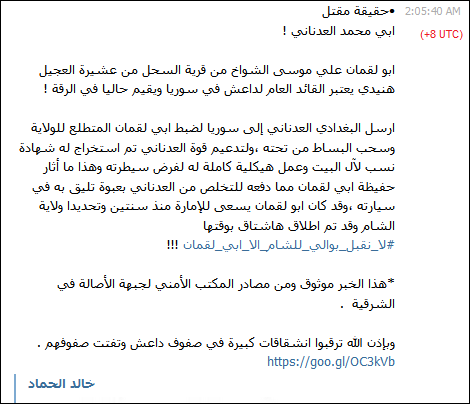
Fig. 7 — A screenshot of a Telegram post by Khaled al-Hammad published at 18:05 UTC on August 30, 2016. The post claims that Adnani was killed by an improvised explosive device placed by IS fighters loyal to Abu Luqman.
That seems to be it as far as open sources go as with regards to al-Hammad, who is the leader of one of the first groups to declare war on IS in eastern Syria. However, Hassan Hassan, co-author of ISIS: Inside the Army of Terror, notes that al-Hammad made a similar claim on Twitter [archived] in January 2015. In that tweet, he speaks of IS infighting with Abu Luqman at the centre and claims that Abu Luqman was killed for that reason. While Hassan sees no base for these claims, the rumours quickly spread on Twitter.
Some others have questioned whether Adnani was really killed, as IS has not published any image of him. A simple reversed image search shows that a photo circulating on Twitter, purportedly showing the face of the killed Adnani, was already online long before August 29.
What does open source tell us about the alleged killing of Adnani?
In the particular case of the alleged killing of Adnani, open source information alone cannot reach a conclusive answer what happened. However, it has been possible to corroborate both the US and Russian claims with open source information. At this point, it is not possible to make conclusive judgements based on this open source information, such as suggestions on the level of precision airstrikes, or previous records on the trustworthiness of claims. It thus show the challenges and limitations of open source surveys and investigations. This post instead provides a survey of the corroborated open source information available at the moment, as seen in the following chronology of the main events:
- August 29, at least from 15:53 to 20:06 UTC, Flightradar24 shows an unidentified aircraft orbiting northeast of al-Bab for over six hours;
- August 30, 9:05 UTC, Radio Hara reports that the SDF moves east after clashes with IS in ‘Um Ḥūsh ‘Um al-Qura;
- August 30, 11:15 UTC, ʻAmāq’s reports a Coalition airstrike on ‘Um Ḥūsh on Telegram;
- August 30, 17:48 UTC, ʻAmāq’s announces of the dead of Adnani on Telegram;
- August 31, 00:22 UTC, the Pentagon publishes a statement that it conducted a precision strike on Adnani near al-Bab. The statement may have been published earlier, but this was the earliest time-stamp retrieved;
- August 31, 11:30 UTC, the Russian MoD publishes a statement that it had targeted IS militants, including Adnani, in ‘Um Ḥūsh.
In sum, the ‘inside IS job’ theory should be treated with suspicion, but the statements made by the US and Russia also remain ambiguous based on a lack of available open source evidence corroborating each claim. Nevertheless, the article may have missed open sources, or sources may emerge. Therefore, anyone is welcome to contribute to this survey, as there are several ‘loose threads’ such as more open source information or eyewitness accounts on the alleged Russian and Coaliton airstrikes. Feel free to make suggestions in the comments.
The author would like to thank several persons for their suggestions to and/or remarks on this open source survey: Hassan Hassan, ‘Has Avrat’, Aric Toler, ‘Abraxas Spa’, Tobias Schneider, ‘obretix’, and Mick Endsor.
Updates:
- September 2, 2016, 15:47 UTC: The following text has been added after a useful suggestion by Twitter-user @LemonSlayerUS: “There is a small but significant difference in the claims of the US and Russian . While Russia said they obtained intelligence that Adnani was among a group of militants struck after the airstrike, the US claims they targeted Adnani.”

